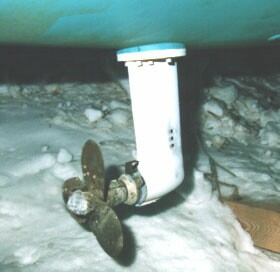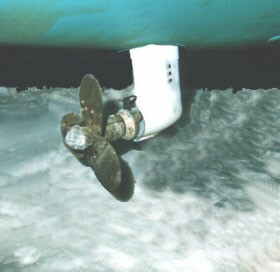Re-examining the Saildrive Mounting Method
The swiss hydraulics company that designed our hydraulic system also came up with the mounting scheme for the saildrive. Thus, we can thank them for the noise and vibration of the sail drives being transferred into hull instead of using the "floating" installation espoused by Volvo.
The Volvo engine, transmission, and saildrive make up a solid block that is suspended on five mounts - four on the engine and one supporting the transmission. Where the saildrive penetrates through the hull, Volvo uses a rubber diaphragm to keep water out, yet allows the saildrive to "float", i.e. gives it a clearance in all directions. The large mass of the engine and transmission coupled with proper engine mounts naturally dampen vibrations.
While Volvo calls for the installation from inside the Prout Catamaran, our legs have been bolted to the exterior skin of the hull as you can see below. The net result is greater drag, higher susceptibility to catch lobster pots, and the inability to beach the boat without risking propeller and saildrive damage.
Is
Exposed propeller and sail drive. Blade tips extend further than the bottom of hull. |
Should be
Sail drive & Prop will not touch ground before keel and rudder does. Also, much smaller target for lobster pots. |
When we inspected the saildrives as part of our propulsion make-over in 2000, we noticed that one of the saildrives had a tiny amount of shavings in the oil, indicating it had hit something hard. Furthermore, it did not help that the shimming in the starboard drive had been incorrect - these drives are very sensitive to proper shimming, and you have to use a micrometer to get it right.
We took the drives apart and discovered that most of the seals were either leaking a little or were about to. It also seemed prudent to replace the roller bearings in the top of the saildrives with new ones that had not been beaten up through improper shimming. Having replaced the seals and the roller bearings, the saildrives were reassembled and shimmed to perfection in the spring of 2000.
The exterior surfaces of the saildrives were refinished then we updated the zincs and the grease on the max-props. An engine test in June 2000 (sans impeller) allowed the engine to flex its muscles. Both saildrives run beautifully, even though it is nearly impossible to prevent them from turning ever so slowly in neutral. Oh well.
If we have another major system failure, we may replace the hydraulic system and the saildrives with something more robust like twin diesel motors. This is a set-up that most mechanics know and won't screw up.
Best Estimate for Time Required:
| Find Source of Volvo Saildrive Parts | 2 hours |
|---|---|
| Order parts, special tools, mechanics handbook | 3 hours |
| Remove/Reinstall Saildrives | 10 hours |
| Disassemble, clean, rebuild, shim saildrives | 8 hours |
| Test Saildrive system and note maximum pressure builds | 3 hours |
| Total | 26 hours |
|---|

